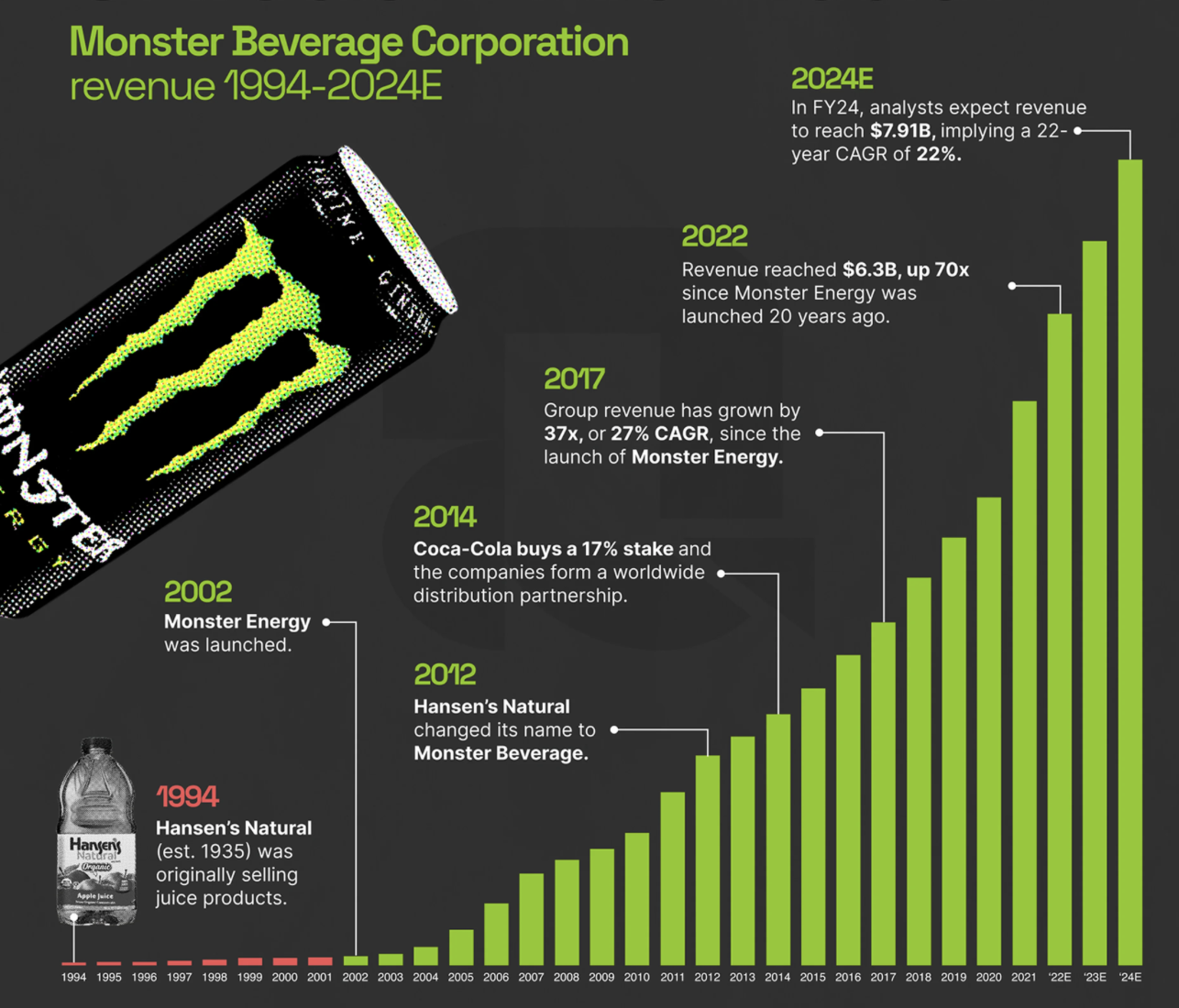Monster
Monster growth in energy drinks
Monster Beverage is the top-performing US business of the past 30 years – a $1,000 investment in 1994 would be worth $2,000,000 in 2024 (+200,000% gain). Based in Corona, California, the company produces a range of energy drinks including Monster Energy, Relentless and Burn, but was originally founded as Hansen’s in 1935 in Southern California, selling juice products. Monster is 20% owned by Coca-Cola and benefits from distribution through its global network.
Monster Beverage Corporation, formerly known as Hansen Natural Corporation, was founded in 1992 by Rodney Sacks and Hilton Schlosberg. Initially, the company focused on producing natural sodas and juices under the Hansen’s brand. However, the pivotal moment came in 2002 when they introduced the Monster Energy drink, a bold move that would shape the company’s trajectory.
Founding
- 1990s: Rodney Sacks and Hilton Schlosberg acquired Hansen’s, a struggling juice company, and began to revitalize it by focusing on natural ingredients.
- 2002: Monster Energy was introduced, targeting the emerging energy drink market. This was a strategic shift from the company’s previous focus on natural juices.

Growth
- Early 2000s: Monster Energy quickly gained popularity, especially among young consumers and extreme sports enthusiasts. Its edgy branding and association with extreme sports events helped it stand out in a crowded market.
- Expansion: Monster aggressively expanded its distribution network, striking deals with major retailers and beverage distributors. International expansion followed suit, further fueling the brand’s growth.
- Diversification: The company expanded its product line to include various flavors and variations of energy drinks, as well as non-energy beverages like teas and juices. This diversification helped mitigate risks and cater to different consumer preferences.
Strategy
- Brand Image: Monster cultivated a rebellious and edgy brand image, targeting a youthful demographic through sponsorships of extreme sports events, music festivals, and gaming competitions.
- Marketing: The company invested heavily in marketing and advertising, leveraging social media, sponsorships, and endorsements by athletes and celebrities to increase brand visibility and appeal.
- Distribution: Monster focused on building a robust distribution network, ensuring its products were widely available in convenience stores, supermarkets, gas stations, and other retail outlets.
- Innovation: Constant innovation in product development, introducing new flavors, formulations, and packaging to keep the brand fresh and competitive.

Success
- Market Dominance: Monster Energy emerged as one of the top players in the global energy drink market, competing fiercely with brands like Red Bull and Rockstar.
- Financial Performance: The company’s revenues soared as Monster Energy’s popularity surged, consistently delivering strong financial results and impressive growth rates.
- Stock Performance: Monster Beverage’s stock price experienced significant appreciation over the years, rewarding investors handsomely.
- Acquisition: In 2015, Coca-Cola acquired a minority stake in Monster Beverage Corporation, further boosting its market presence and providing access to Coca-Cola’s extensive distribution network.
